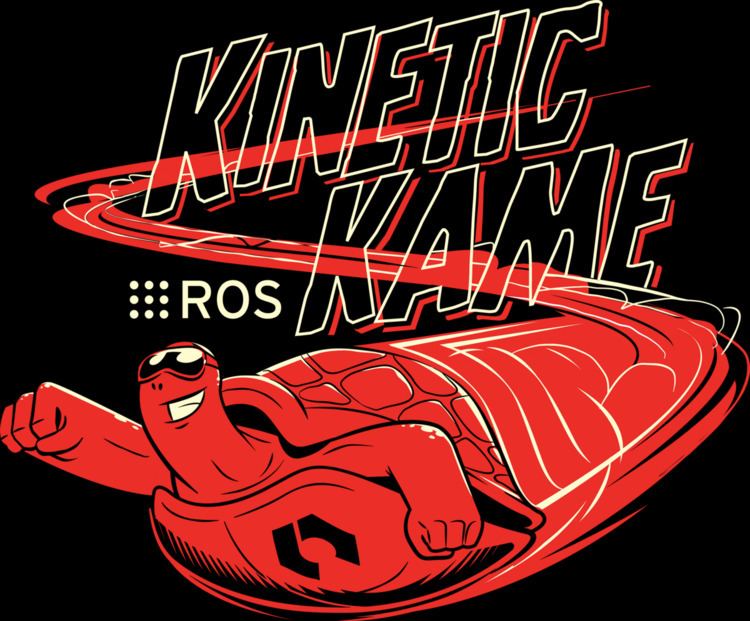Development status Active Operating system | ||
 | ||
Original author(s) Initial release 2007; 10 years ago (2007) Stable release Kinetic Kame / 23 May 2016; 9 months ago (2016-05-23) | ||
Robot Operating System (ROS) is a collection of software frameworks for robot software development, (see also Robotics middleware) providing operating system-like functionality on a heterogeneous computer cluster. ROS provides standard operating system services such as hardware abstraction, low-level device control, implementation of commonly used functionality, message-passing between processes, and package management. Running sets of ROS-based processes are represented in a graph architecture where processing takes place in nodes that may receive, post and multiplex sensor, control, state, planning, actuator and other messages. Despite the importance of reactivity and low latency in robot control, ROS, itself, is not a real-time OS (RTOS), though it is possible to integrate ROS with real-time code. The lack of support for real-time systems is being addressed in the creation of ROS 2.0.
Contents
Software in the ROS Ecosystem can be separated into three groups:
Both the language-independent tools and the main client libraries (C++, Python, LISP) are released under the terms of the BSD license, and as such are open source software and free for both commercial and research use. The majority of other packages are licensed under a variety of open source licenses. These other packages implement commonly used functionality and applications such as hardware drivers, robot models, datatypes, planning, perception, simultaneous localization and mapping, simulation tools, and other algorithms.
The main ROS client libraries (C++, Python, LISP) are geared toward a Unix-like system, primarily because of their dependence on large collections of open-source software dependencies. For these client libraries, Ubuntu Linux is listed as "Supported" while other variants such as Fedora Linux, macOS, and Microsoft Windows are designated "Experimental" and are supported by the community. The native Java ROS client library, rosjava, however, does not share these limitations and has enabled ROS-based software to be written for the Android OS. rosjava has also enabled ROS to be integrated into an officially-supported MATLAB toolbox which can be used on Linux, macOS, and Microsoft Windows. A JavaScript client library, roslibjs has also been developed which enables integration of software into a ROS system via any standards-compliant web browser.
History
ROS was originally developed in 2007 under the name switchyard by the Stanford Artificial Intelligence Laboratory in support of the Stanford AI Robot STAIR (STanford AI Robot) project. Description of STAIR on its homepage:
Our single robot platform will integrate methods drawn from all areas of AI, including machine learning, vision, navigation, planning, reasoning, and speech/natural language processing. This is in distinct contrast to the 30-year trend of working on fragmented AI sub-fields, and will be a vehicle for driving research towards true integrated AI.
From 2008 until 2013, development was performed primarily at Willow Garage, a robotics research institute/incubator. During that time, researchers at more than twenty institutions collaborated with Willow Garage engineers in a federated development model.
In February 2013, ROS stewardship transitioned to the Open Source Robotics Foundation. In August 2013, a blog posting announced that Willow Garage would be absorbed by another company started by its founder, Suitable Technologies. The support responsibilities for the PR2 created by Willow Garage were also subsequently taken over by Clearpath Robotics.
Applications
ROS areas include:
ROS package application areas will include:
ROS-Industrial is a BSD-licensed “hardware-agnostic” software development program to create a Unified Robot Description Format (URDF) for industrial robots.
Version history
ROS releases may be incompatible with other releases and are often referred to by code name rather than version number. The major releases so far are:
Ports to robots and boards
ROS packages
ROS contains many open source implementations of common robotics functionality and algorithms. These open source implementations are organized into "packages". Many packages are included as part of ROS distributions, while others may be developed by individuals and distributed through code sharing sites such as github. For a list of some of the available packages for ROS, see: http://www.ros.org/browse/list.php
